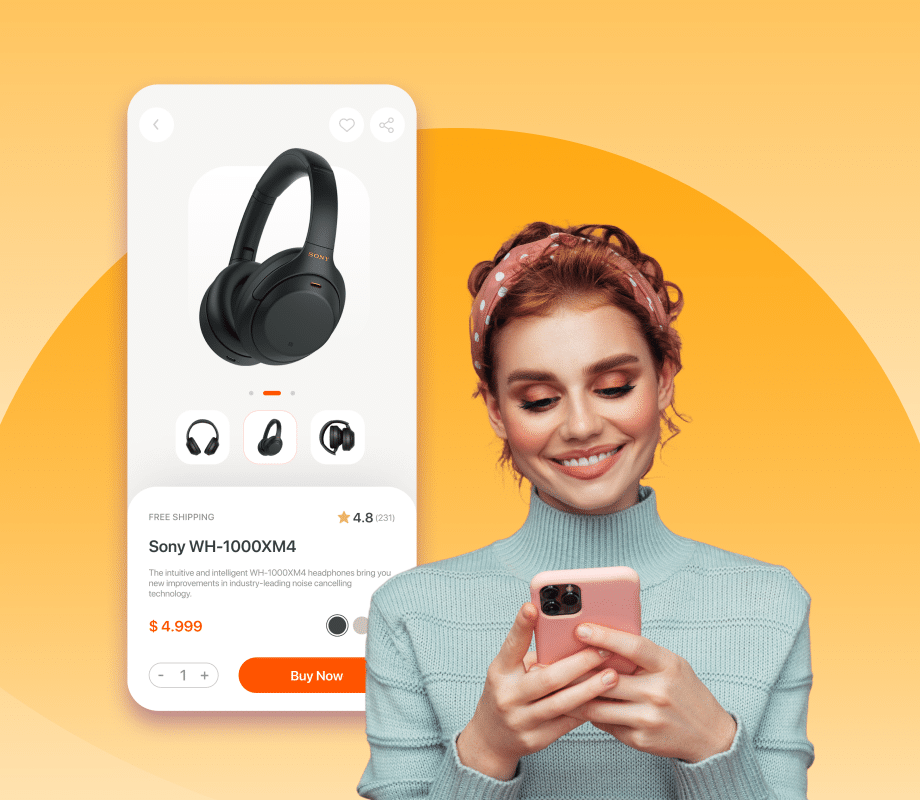Evolution of Ecommerce Personalization: A Look at Trends in 2024
A retailer’s guide to essential practices for mastering customer engagement

To say that ecommerce – the shopping channel we all love and enjoy in our filled-with-convenience lives – has risen to new heights is an understatement.
Global ecommerce sales are projected to increase 9.4% year-over-year to $6.3 trillion in 2024.1 By 2026, the number will be $8 trillion.2
The pace of change across the ecommerce landscape is unrelenting. Customers are shifting their preferences to a predominantly digital buying experience quicker than previously forecast.
How can retailers keep up? The answer has been becoming more apparent in the post-pandemic era: an ecommerce personalization strategy. When a global event precipitates adopting digital-first shopping experiences, people long for human-like, contextual guidance tailored to their needs.
This article delves into how personalization can elevate customer engagement, foster brand loyalty, and ultimately drive your profits upwards. Read on to discover how to incorporate personalization into your retail strategy and reap the rewards!
But first – what is personalization?
What Is (and Isn’t) Personalization?
According to Epsilon Research, 80% of respondents say they are more inclined to do business with an organization that delivers tailored experiences, and 90% say personalization is desirable.3
Ecommerce personalization involves crafting a distinctive journey for each shopper across various touchpoints and channels. This personalized experience is shaped by historical data and real-time shopper intent and is driven by customer and product intelligence insights. The ultimate aim is to instill a sense of uniqueness and emotional connection, enhancing the overall shopping experience.
It’s equally important to know what personalization is not.
Traditional shopper segmentation tends to treat individuals as part of a cohort, emphasizing shared tastes and interests within a group. This approach categorizes, labels, and boxes people rather than acknowledging them as unique individuals with particular preferences and needs.
The limitations of segmentation become evident when it results in seemingly irrelevant personalization, such as recommending mosquito nets to someone who recently purchased one or flooding someone’s inbox with promotional discounts on cutlery after they bought a dinner set. These instances don’t signify a lack of personalization but highlight the pitfalls of irrelevant personalization, which can be considered a failure.
The challenge lies in personalizing experiences and ensuring they are relevant, timely, and aligned with individual shoppers’ unique preferences and needs.
How do you do this at scale? By leveraging artificial intelligence.

Segmentation does not equal personalization
Traditional shopper segmentation categorizes, labels, and boxes people rather than acknowledging them as unique individuals with specific preferences and needs.
AI-Powered Personalization
AI’s ability to process data in real time and adapt on the fly to create personalized experiences is a crucial advantage for ecommerce brands. It also helps that AI isn’t prone to human mistakes and can work 24/7. It goes beyond traditional personalization methods by leveraging advanced algorithms, machine learning, and data analytics to scan volumes of customer data and deliver information to an individual based on one’s specific behavior.
In the context of ecommerce, this might involve dynamically adjusting product recommendations, optimizing website content based on user engagement patterns, tailoring the search and browsing experience to accelerate discovery, and even predicting future preferences to create a seamless and personalized shopping journey.
Retailers have taken note. AI-powered ecommerce solutions are expected to form a market of $16.8 billion by 2030, with a CAGR of 15.7% over the next eight years.4 Consumers see value in it, too. A quarter of millennials (26%) say they have used an AI tool to help with shopping in the past 30 days. Moreover, users of such tools say they found them helpful and unique.5
And what do you need to personalize with AI successfully? Data, algorithms, and a bridge to connect disparate sources of truth.
- Rich and Relevant Data: AI thrives on data. To effectively personalize the customer experience, ecommerce platforms require access to a comprehensive dataset, including user preferences, behaviors, purchase history, and contextual data such as location and device type.
- Robust AI Algorithms: The effectiveness of AI-powered personalization relies on the sophistication of the underlying algorithms. Powerful machine learning models are essential for analyzing and interpreting complex datasets, continuously learning from user interactions, and refining personalization strategies over time.
- Seamless Integration: AI solutions should seamlessly integrate with existing ecommerce systems, ensuring a smooth flow of data and insights. Compatibility with various platforms and technologies is crucial for a cohesive and unified personalization strategy.
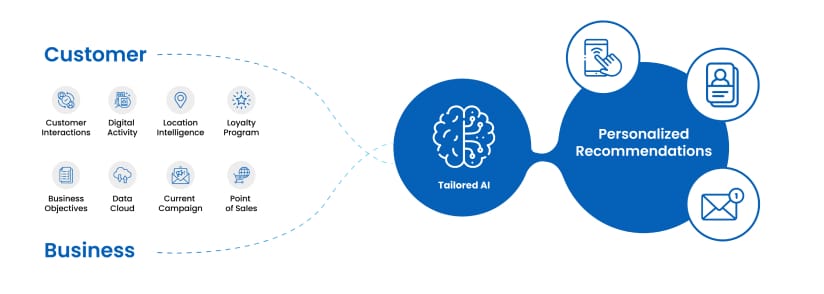
AI combines data from disparate sources to personalize customer experience
AI-powered ecommerce solutions are expected to form a market of $16.8 billion by 2030.4
Personalization in Practice
As you may have realized by now, personalization isn’t just a buzzword; it’s a strategic imperative. Let’s explore how you can employ cutting-edge personalization tactics to drive revenue and forge lasting customer connections.
Homepage Personalization for Anonymous and First-Time Visitors
Trend: Solving Cold Starts with the ‘Wisdom of the Crowd’ Strategy
In the realm of anonymous, first-time visitors, the challenge lies in kick-starting engagement without historical data. Most shoppers enter a site from the home page. How do you personalize home page experiences for these new and not-logged-in users? The solution is to introduce top sellers based on the ‘wisdom of the crowd’ or collective preferences. As intuitive as it sounds, it is a game-changer.
Imagine a first-time visitor exploring your online fashion boutique for the perfect winter sweater. With your personalization engine set to adopt a ‘wisdom of the crowd’ approach for new visitors, you greet them with a stunning display of cozy knitwear and stylish winter essentials since they are trending among other shoppers.
And the next time they visit the website, personalized web pages surface the specific kinds (color, style, brand, price range, etc.) of products they have an affinity for. This customized touch transforms their cold start into a warm, engaging shopping experience.
Case Study: Zalora Improves Average Basket Size With ecommerce Personalization – Algonomy

First-time visitors see trending and top-selling items
Always-Improving Product Recommendation Engine with Machine Learning
Trend: Leveraging Powerful Affinity Profiling for Optimal Suggestions
The cornerstone of 1:1 ecommerce personalization is using machine learning to offer precise product recommendations. It goes beyond basic algorithms, delving into robust affinity profiling in real time. With each digital interaction, the user’s affinity profile evolves, creating a nuanced understanding of their preferences and, in turn, powering contextual algorithmic decisioning. This data-driven approach allows ecommerce platforms to provide tailor-made experiences across every touchpoint.
Let’s take the example of Sarah, a conscious shopper passionate about sustainable living. As she explores a marketplace, her browsing and click-through behavior, searches, and interactions fuel the platform’s machine-learning algorithms to recognize her preference for sustainable fashion. If she’s a logged-in user, then the personalization engine combines this behavioral data with the attributes of her unique customer segment to augment her real-time profile.
Beyond showing eco-friendly clothing, the ecommerce recommendation engine seamlessly suggests accessories and footwear that align with her values. This personalized journey increases Sarah’s average order value and contributes to an impressive rise in conversion rates.
Algonomy Recommend™ provides an exhaustive library of 150+ recommendation strategies that can be employed out of the box for a shorter time to value. Xen AI, Algonomy’s decisioning engine, selects the ‘king of the hill’ – the most effective strategy from this library – to tailor each customer interaction. Depending on merchandising priorities, you could show the most suitable recommendations at different locations and points in the shopper journey.
Here are two everyday use cases:
- Product Pages: On the product detail page, you can show customers items that are frequently bought together – suggesting complimentary products they’d need with their purchase. If you have data showing that the shopper tends to check out products from a particular brand more than others, you can cater to their tastes with more suggestions from that brand.

- Cart Checkout: When the customer is about to complete their purchase, you can suggest often-bought-together items or products that match their purchase. For example, if they are about to buy an electronic device, you can offer a protective case or batteries. If a recurring customer purchases items they purchased before, AI can detect if they’ve left something out and remind them to add them to their cart.

AI for a Personal Shopper Experience
Trend: Enhancing Product Discovery with Image & Textual Intelligence
Have you ever been out shopping, seen a bunch of exciting apparel items, fallen in love with a few, and yet don’t know how you will style it all together? Ever seen a gorgeous centerpiece for your dining table but didn’t find a table linen to go with it and ended up dropping the idea altogether?
Shoppers on ecommerce websites face this block all the time. With an AI recommendation engine like Algonomy DeepRecs™, retailers can digitally replicate the rich in-store experience with advanced Visual AI and text/NLP-based personalization in real time, mimicking human-like curation.
Visual AI
Visual AI, powered by deep learning, is revolutionizing product discovery for ecommerce shoppers, hoping for some help in narrowing down what items, when bought together, will maximize visual appeal. It “looks at” the actual contents of an image and extracts features such as design patterns, colors, and styles automatically. The visual recommendation engine then identifies priority aspects and displays similar-looking and compatible products.
Meet Alex, a fashion enthusiast browsing for new pants. She lands on a product she likes – black, striped, mid-rise lounge pants. DeepRecs Visual AITM gets to work and surfaces recommendations for similar-looking products with slight variations in the thickness of stripes, color combinations, the fit of the pants, etc.
It goes further by leveraging image intelligence to suggest other apparel items and accessories that will complement the pants she is looking at. These ‘complete the look recommendations’ enrich her visualization and maximize exposure to relevant accessories in the catalog. Hence, she also sees tops, sunglasses, hats, and belts that would gel with her pants.

Shoppers can browse lookalike and complementary products with Visual AI
Product Discovery via Natural Language Processing (NLP)
Images are great, of course. But catalogs will only sometimes have the most updated and high-quality photos. Even so, there’s great value in describing something in detail. Consumers look to text descriptions – and marketing copy – to learn about several product attributes such as material, dimensions, occasion, the mood or feeling a product could evoke, etc.
Deep learning models on product discovery platforms utilize this wealth of written information to find and surface new, seasonal, and long-tail products that would otherwise be buried due to a lack of behavioral or co-purchase data.
In the example illustrated below, the shopper looks at a floral arrangement. Its colors are Christmas-themed, and it’s made up of red roses that evoke a ‘warm, holiday dinner’ aesthetic.
DeepRecs NLPTM extracts attributes from the product description (even reviews) and finds related products based on feature complements, semantic similarity, and word vectors. It recommends a dining table runner with red flowers and holly leaf motifs for their ‘cozy, festive’ decorations.
Case Study: Game-changing DeepRecs NLP Improves Product Discovery of 2M+ Catalog with 96% Long-tail Items

NLP can uncover complementary products based on word associations
Ensemble AI
Trend: Boosting AOV with Personalized Styling Advice
Online product pages often leave shoppers feeling uninspired about how to put together different pieces. As shoppers can not see the full potential of an item, this leads to missed sales. Merchandisers need a way to create shoppable looks and styling advice that is not manual or resource-intensive.
Ensemble AI makes that possible. It is based on ‘wisdom of the crowd’ co-occurrence data, complementary color detection, and shoppers’ behavior and preferences. This intelligence will recommend several options (each a complete outfit or an ensemble) for styling – keeping the shopper’s product of interest as a constant. They can then pick from all the combinations that resonate with the outfit they first liked and shop an entire look – rather than just one piece of the puzzle.
Ensemble AI offers the shopper automated “How to Style it” suggestions that showcase curated outfits for their selection, boosting product discovery and purchase interest. The retailer saves time and money while ensuring a consistent brand aesthetic, and the shopper experiences a seamless and visually appealing ensemble suggestion, leading to an increase in average order value (AOV) and user engagement.
Algonomy Ensemble AI is a way to cross-sell your products while delighting your customers. It empowers merchandisers to create stunning outfits, product collections, or recommended bundles effortlessly. What’s in it for the shoppers? Pre-curated looks take the guesswork out of assembling an outfit, reducing decision fatigue and improving shopping satisfaction.
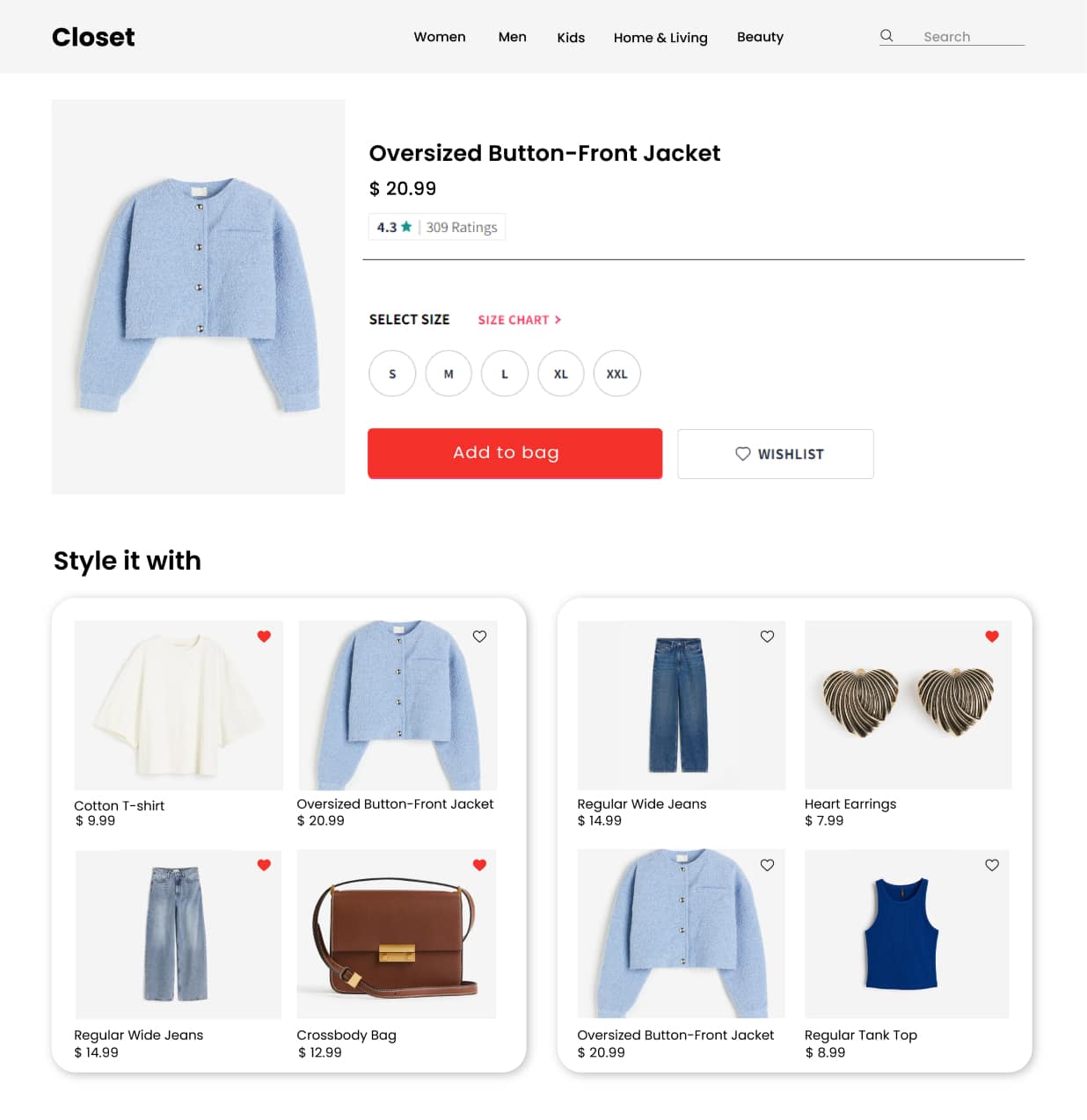
Curated looks make it easier for customers to visualize and assemble outfits
Guided Selling
Trend: Personalizing Recommendations Based on Voluntary Responses by Shoppers
Guided Selling introduces a new frontier in personalization by incorporating ‘zero-party data’ – information willingly shared by shoppers. The shopper is presented with an interactive questionnaire. Upon submission of the quiz, products are dynamically selected based on a combination of the shopper’s inputs and behavioral data that has already been gathered about them. Guided Selling extends its utility even when shoppers make purchases on behalf of others, as is often the case when buying gifts.
Picture Emily, a shopper looking for the perfect birthday gift for her friend. By presenting a series of well-crafted questions on the recipient’s preferences, interests, and occasion, Guided Selling can intelligently suggest the most suitable gift options, ensuring that the chosen gift resonates with the recipient.
With Guided Selling, powered by Algonomy Recommend™, personalization isn’t limited to the current shopping session. It extends its reach into future interactions with the shopper. How? By seamlessly integrating the shoppers’ responses into their real-time customer or User Profile (UPS).
This integration allows optimization managers to apply merchandising rules based on these answers later in the shopping journey, creating an ongoing cycle of personalization. Imagine a beauty product quiz revealing that a shopper has blue eyes – future recommendations can now align with this attribute/preference.
Gift finders ask shoppers a series of questions to find the best matches
Personalized Content and Promotions
Trend: Leveraging Advanced Audience Segmentation for Targeted Promotions
Personalized promotions go beyond generic deals and discounts. By harnessing advanced audience segmentation, ecommerce platforms can tailor promotions based on user intent. Such promotions include campaigns triggered by inventory and shopper events, such as rescuing cart abandonment, cross-selling in order confirmation emails, and re-engaging customers in case of order cancellation.
One of the strategies involves serving different variations to low-intent versus high-intent buyers in a single email send, optimizing time and driving more purchases from each audience segment.
Here’s an example. Let’s meet Jason, a savvy shopper who occasionally browses and adds stuff to his cart but has yet to purchase. The platform serves Jason exclusive discounts in a targeted email campaign, rekindling his interest. Simultaneously, high-intent buyers receive early access to a sale.
This approach removes the guesswork from your decisions – content that drives revenue will automatically be served as it’s A/B tested in real time. Algonomy Engage™ does just this and more.
Mapping individual customer behavior to advanced segments allows retailers to serve website content personalization and promotions while staying aligned with their brand strategy. A robust set of templates and triggers can help you configure and customize personalized messages using overlays, embeds, pop-ups, landing pages, and other CTA layouts on demand.

High-intent buyers receive early access to a sale while low-intent buyers get unique discount codes
Personalized Search and Discovery
Trend: Crafting Intuitive Search Experiences with AI
Did you know? 69% of retail customers head directly to the search bar on a website, and 80% of shoppers exit a brand’s site because of poor search.6
A robust personalized search engine should go beyond mere query-based results; it should embrace self-learning capabilities to enhance conversions significantly. A self-learning search adapts in real-time, continuously refining results based on the shopper’s behavior across various touchpoints, including recommendations and content interactions.
Algonomy Find™ takes this further, utilizing diverse machine learning algorithms like ‘wisdom of the crowd’ to ensure relevance, especially when search queries lack precision. By integrating with generative AI, it not only provides results for the main query but also anticipates related searches. The interactive search experience includes predictive autocomplete and integrates informative content like brand videos and blogs into the results.
Algonomy Find™ doesn’t just adapt to B2C; it extends its capabilities to the B2B context, curating experiences based on contractual agreements, pricing structures, and individual preferences, delivering a comprehensive and tailored search journey.
Meet Emily, a valued customer exploring your online store for the perfect summer dress. Since personalized search is active on your ecommerce site, it anticipates her intent, offering suggestions and completing her queries. Its self-learning capabilities ensure accurate results, employing ‘wisdom of the crowd’ for collective preferences even with broad queries like “summer dresses.”
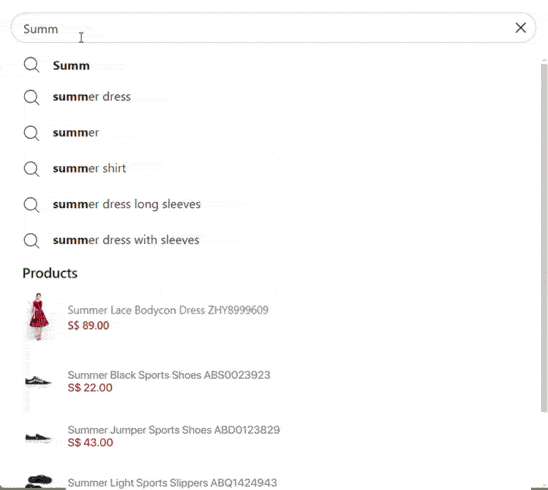
Personalized search refines autocomplete suggestions and results in real time
Transforming the search experience in 2024 means enabling shoppers to zero in on the most context-aware result in the blink of an eye. Being able to do that needs personalized sorting. An AI-powered search and discovery engine will re-sort the product display in real time, instantly matching the shoppers’ current and past preferences as they browse, as if you were re-arranging the in-store display for every visit!
Algonomy Discover™ alleviates decision fatigue for shoppers by dynamically reorganizing products and facets from the first click. You can customize the importance assigned to various attributes—such as product, price, newness, and brand—to influence non-personalized and personalized search results and test to determine the most impactful browse and navigation personalization settings.
For example, Emile is a shopper on your site. You can transform his discovery experience by dynamically curating the display of personalized results based on his evolving preferences and reorganizing facets to ensure he finds what he seeks and enjoys seamless navigation. As Emile explores, the system learns from his preferences, presenting personalized 1:1 results that align with his style.
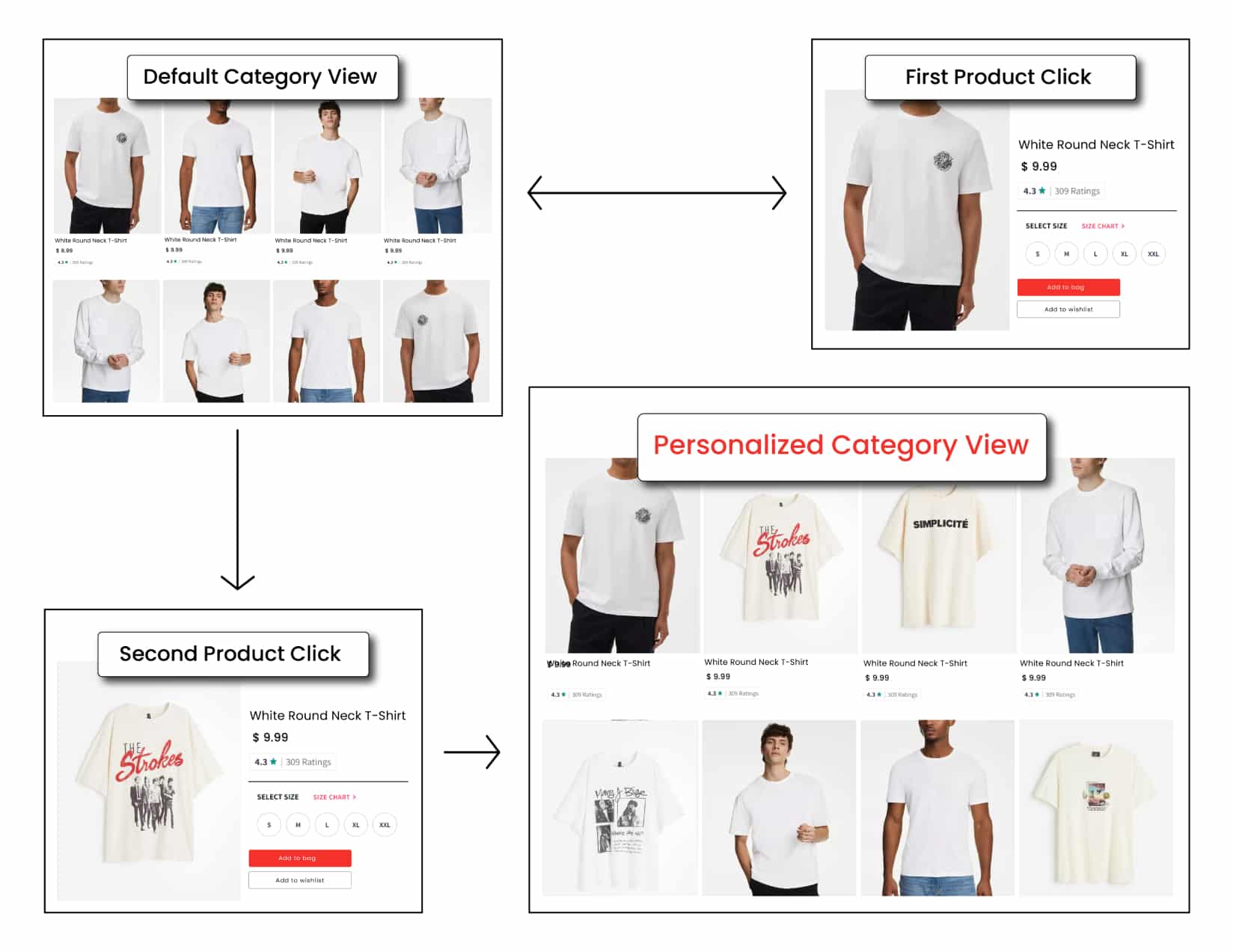
Merchandisers can rearrange displays automatically based on a shopper’s evolving preferences
There’s another way through which Algonomy’s search & discovery solutions can significantly improve product discovery for your shoppers. With the help of generative AI, the personalization engine can enrich your product catalog with specific attributes and descriptions that define a product. This enhanced information – ‘recycled material’ for shoes, ‘slightly smoky aroma’ for wines, ‘semi-sheer transparency’ for dresses, and so on – helps shoppers discover products that meet their nuanced requirements.
Social Proof Messaging
Trend: Instilling Shopper Confidence with Visible Social Patterns
Online shopping lacks experiential elements such as cues on what products others in the store view and buy. It is common for shoppers to second-guess their decision and drop off after actively considering products. Social proof messaging is the practice of signaling to customers if the product they are viewing is in demand. It helps shoppers validate their decisions and nudges them to add products to the cart, improving critical metrics like conversion rate and revenue.
Let’s say David is a cricketing enthusiast and wants to buy a new bat for his upcoming match on your website. With social proof messaging activated, you can show him messages like ’15 people bought this today’, ‘On fire – viewed 67 times in the last 30 minutes’, ‘Selling fast – only three left’ etc. What’s more, you can make the messages more personalized! For example, ‘8 people added to cart since your last visit’ or ‘Popular with batsmen.’
With Algonomy Social Proof, you can easily customize the messaging and choose from real-time metrics such as the number of views, purchases, add-to-carts, or even product inventory levels. In addition, social proof messaging can be used on pages across the shopping funnel – home page, category pages, product pages, or even at the bottom of the funnel on add-to-cart pages.
Case Study: A US-based Outdoor Gear and Apparel Retailer Accelerates ecommerce Conversions with Social Proof Messaging

Social proof nudges shoppers to buy by displaying availability and purchase info
Personalized Product Finder via Chatbots
Trend: Simplifying Discovery and Elevating Engagement with Conversational AI
Imagine walking into a physical store and having no one to talk to! Online, too – when your shoppers are confronted with too many menu items, they will face analysis paralysis and soon disengage. A chatbot takes on the role of a conversational product finder that provides personalized shopping experiences for your customers and makes them purchase faster.
One study notes that 58% of customers say emerging technologies like chatbots and voice assistants are changing their expectations of companies.7 Customers expect human-like assistance on ecommerce channels, and often, the first step is to get them to the product they are looking for.
A chat interface accomplishes that by asking customers questions about their product preferences. The chatbot uses large language models to present shoppers with options of what they need to explore. The shopper can directly jump to the relevant section from the chat without navigating the website.
For example, Pat needs to find a gift for his wife. A chatbot pops up and offers to help him find what he wants. It strikes up a conversation with Pat – asking him questions and listening to his responses to present a list of items he can choose from.
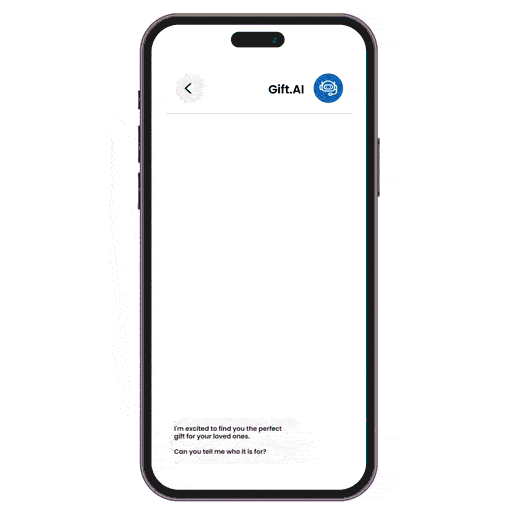
Chatbots recommend products based on engaging conversations about a shopper’s needs & preferences
Closing Thoughts
In the ever-evolving realm of ecommerce, the pivotal role of personalization becomes even more pronounced as we surge into 2024. It is not merely a strategic choice; it has become necessary for retailers aiming for transactions and enduring customer engagement.
The trends unveiled in this exploration paint a vivid picture of how personalization, powered by AI, is reshaping the dynamics between retailers and consumers. It transcends the conventional boundaries of static shopping experiences, ushering in a new era of dynamic, real-time, and anticipatory interactions.
What sets the path to success apart is understanding what shoppers want and predicting their needs before they articulate them. Algonomy spotlights this fusion of rich and relevant data, robust AI algorithms, and seamless integration, which forms the nexus of personalization triumph.
As Algonomy propels the discourse towards customer engagement, it underscores that this evolution isn’t just about shopping—it’s about creating memorable, intuitive, and profoundly human experiences that foster lasting connections between brands and their valued customers. In this future, personalization is not a feature; it’s the very essence of a vibrant and engaged customer-retailer relationship.
Learn more about Algonomy’s digital experience personalization solutions here.
References
- 1https://www.shopify.com/blog/global-ecommerce-sales
- 2https://www.statista.com/statistics/379046/worldwide-retail-ecommerce-sales
- 3https://www.epsilon.com/us/about-us/pressroom/new-epsilon-research-indicates-80-of-consumers-are-more-likely-to-make-a-purchase-when-brands-offer-personalized-experiences
- 4https://www.businessdit.com/ai-in-ecommerce/
- 5https://pro.morningconsult.com/analyst-reports/consumer-views-generative-ai-ecommerce
- 6https://www.nosto.com/blog/searchresearch2023/
- 7https://www.businessinsider.in/tech/enterprise/news/why-customers-still-prefer-speaking-to-a-human-not-chatbox/articleshow/91955173.cms



